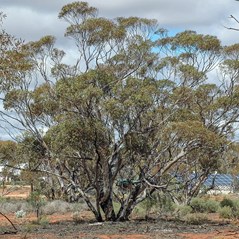Uses: For open areas, wider verges, batters, parks and reserves, as a shelter wind-break or erosion control. Good plant for honey production.
Attracts nectar eating birds and insects for food and habitat. The seeds of this species have been found to be a food source for the Yellow-tailed Black-Cockatoo. Growing these plants in small stands between open space will help encourage the return of this endangered native bird
Note: This species is classified schedule 2, Regulation 24.3 under the
Sewerage Act and may be planted in any street or road in any drainage area provided they are not planted closer than 3.5 metres to any sewer main or connection. They should also not be planted closer than 3.5 metres to any sewer pipe in home gardens.
This plant is indigenous to the following botanical regions of South Australia.
:NU: Nullarbor
:GT: Gairdner-Torrens
:FR: Flinders Rangers
:EA: Eastern
:EP: Eyre Peninsula
:NL: Northern Lofty
:MU: Murray
:YP: Yorke Peninsula
:SL: Southern Lofty
:KI: Kangaroo Island
For detail on these regions refer to the user guide.
- Canopy Shape Open
- Height 3-18m
- Spread 4-10m
- Position
- Full Sun
- Family Myrtaceae
- Botanical Name Eucalyptus gracilis
- Common Name Yorrell
- Origin SA, Vic, NSW, WA,
- Habit Open to spreading, Multi-trunked
- Landscape Coast, Coastal footslopes, 2nd line coast, Plains
- Soil Texture Clay, Loam, Sand
- pH Acidic, Alkaline, Neutral
- Tolerates Drought, Lime, Moderate frost
- Supplementary Watering Minimal
- Flower Colour Cream, White
- Flowering Time Autumn, Spring
- Foliage Mid-green
- Flower Type Eucalypt-type
- Purpose Ornamental, Habitat
- Evergreen/Deciduous Evergreen
- Trunk Rough
- Form Tall Tree (Usually exceeds 10m)
- Indigenous to the Adelaide Region







